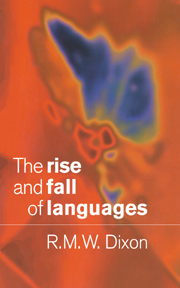Book contents
- Frontmatter
- Contents
- Acknowledgements
- 1 Introduction
- 2 Preliminaries
- 3 Linguistic areas and diffusion
- 4 The family tree model
- 5 Modes of change
- 6 The punctuated equilibrium model
- 7 More on proto-languages
- 8 Recent history
- 9 Today's priorities
- 10 Summary and prospects
- Appendix – where the comparative method discovery procedure fails
- References
- Index
4 - The family tree model
Published online by Cambridge University Press: 05 June 2012
- Frontmatter
- Contents
- Acknowledgements
- 1 Introduction
- 2 Preliminaries
- 3 Linguistic areas and diffusion
- 4 The family tree model
- 5 Modes of change
- 6 The punctuated equilibrium model
- 7 More on proto-languages
- 8 Recent history
- 9 Today's priorities
- 10 Summary and prospects
- Appendix – where the comparative method discovery procedure fails
- References
- Index
Summary
There has been a persistent tendency in linguistics to take one idea (which could never be more than part of the whole picture) cind to overapply it. This is evident in most recent grammatical theories. And it certainly applies to the branching family tree model for linguistic splitting and relationship.
In the ideal family tree situation we get one original language splitting into a small number of daughter languages (in the best instance, two), each of these in turn splitting into a small number of daughter languages, and so on. This model was developed for the Indo-European family and is broadly applicable to it. There are, however, a number of less than ideal features of the IE family tree. The first is that we appear to need a primary split into ten branches – it has not been possible to reach any consensus on further articulation within this ten. That a single ancestor language should split simultaneously into ten daughters is unlikely. (In §7 we shall examine an alternative scenario.) There is also the difficulty that some languages cannot be assigned a clear place within the tree; for instance, Singhalese is acknowledged to belong to the Indo-Aryan branch, but it cannot be assigned to any specific node within this branch.
Work on Indo-European is, by and large, of the highest quality and has acquired a justified prestige. (Add to this the fact that the IE languages themselves include the major prestige languages in the world today.) As a result the family tree is the ‘received model’ of linguistic relationship which scholars working in other areas attempt to apply to their own groups of languages.
- Type
- Chapter
- Information
- The Rise and Fall of Languages , pp. 28 - 53Publisher: Cambridge University PressPrint publication year: 1997



